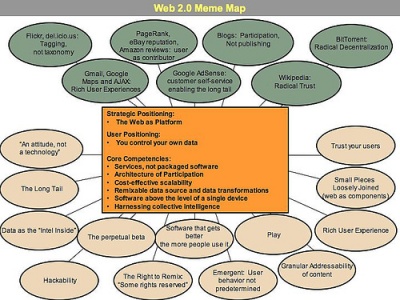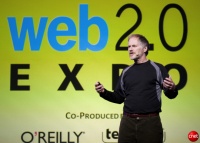Web 2.0
Web 2.0 is the expression used to describe the second generation of websites that moves past static HTML webpages and into a more interactive World Wide Web.[1][2]Web 2.0 allows the user to do more than read a webpage. Web 2.0 websites allow the user to collaborate, share, and integrate their own ideas with an Internet community. Web 2.0 components include open sourced communication and user-generated content from applications such as Social Networking, blogs, forums, Wikis, RSS, etc. Tim O’Reilly and O’Reilly Media defined the term as “the web as a platform.”[3] The term Web 2.0 does not equate to a change in technology, but rather the change in how designers and users use the Internet. Web 2.0 is not synonymous with the term “Semantic Web” – the design format that allows for Web 2.0 to be possible by using XML technology. [2][4] Web 2.0 websites raise ethical concerns, including that of privacy and anonymity online. Because internet use and contributions through Web 2.0 are rising in popularity, some philosophers such as Luciano Floridi believe that the web needs a set of ethical guidelines separate from real-world ethical norms.
Contents
History
The phrase “Web 2.0” was originally coined in 1999 but did not reach a widespread audience until the O’Reilly Media Web 2.0 conference in 2004. Tim O’Reilly and his colleagues did not know specifically what “Web 2.0” would mean; and instead had a strong stance that the World Wide Web they knew at the time was about to change.[5]
In the early 2000s, just before the time of the 2004 Web 2.0 conference, popular static websites were not advancing as much as users and investors had anticipated. The dot-com bubble lead to rapid financial growth but eventually collapsed as a majority of websites discontinued making money and progress.[6] Companies that survived the collapse were all under the Web 2.0 category because they were able to move past the static web pages and into a more collaborative approach.[7]
Differences between Web 1.0 and Web 2.0
The evolution from the static Web 1.0 to the interactive Web 2.0 can be represented by Web 1.0’s expert-generated content vs. Web 2.0’s user-generated content. Prior to Web 2.0, experts authored most Internet publications; all the user was permitted to do was browse and read. There were limited content creators in Web 1.0.[8] Web 2.0 offers users the chance to provide their own viewpoint on anything being discussed on the Web, and circulate this information on the Net.
Web 2.0 transitions information distribution from a mass broadcasting media dominated industry to an interactive, user-to-user based information-sharing interface. A wider range of information is accessible through Web 2.0, contrasted from mass media’s gatekeeping tendencies. Web 2.0 can describe a social phenomena originating from innovative types of online communities and social networks.[9]
Web 1.0 websites primarily used the top-down approach when designing user interfaces.[8] The top-down approach starts with a homepage with a core theme throughout the webpage, but restricts user participation and links to other webpages. Web 2.0 website design differs in that it allows for more possibility for user participation and collaboration while maybe webpages simpler and more efficient to use. Instead of providing all intelligible information on the webpages, Web 2.0 websites are designed to let the user create the majority of the content.[9]
Disbelievers of the difference
Critics of the term “Web 2.0” generally say it does not deviate much from the original Web 1.0. Some say that with a plethora of Web 2.0 websites, there is great potential for another dot-com bubble, proposing there is an overabundance of similar websites, which hinders progress.[1]
Web 2.0 applications
Social media
At its bare bones, social media and social networking websites are a platform for communication on the World Wide Web.[10] Social media exemplifies many characteristics of Web 2.0 including user generated content and user-to-user interaction. Examples of social media websites include Facebook, Twitter, Google+ and MySpace.
Blogs
Webopedia defines a blog as “a Web page that serves as a publicly accessible personal journal for an individual. Typically updated daily, blogs often reflect the personality of the author." [11]
Wikis
As described by Wikipedia, a wiki is “a website which allows its users to add, modify, or delete its content via a web browser usually using a simplified markup language or a rich-text editor.”[12] Wikipedia is an example of a wiki.
Forums
An Internet forum or message board is a website or part of a website where users can have an online discussion about any one of various topics. Reddit is an example of an Internet forum.
Ethical implications
Advocates of Web 2.0 say that Web 2.0 gives the user a voice that was nonexistent prior to its conception. They cite the point that user generated content published on the web can now potentially reach an unlimited amount of people. Activists for the continued use for Web 2.0 applications like Clay Shirky, believe that all this information will lead to more individuals having an opportunity to gain power. It is now possible for someone who is unknown in the global perspective to have his or her voice heard in a vast spectrum.[13] A fear of non-expert sources seizing the information world scares some academic minds into thinking social media will therefore make the younger generation dumber.[14]
Many of these scholars note the downside of spamming and trolling caused by user authorship. There is much debate amongst Web 2.0 websites and governing bodies about what user-generated material should be censored. Another concern is that many Web 2.0 users can create anonymous account information, which can make information published on these websites not credible.
See also
- Internet Archive
- The Open Internet
- Privacy in Social Networking
- Social Networking Services
- Social Networking
References
- ↑ 1.0 1.1 http://en.wikipedia.org/wiki/Web_2.0
- ↑ 2.0 2.1 http://www.webopedia.com/TERM/W/Web_2_point_0.html
- ↑ http://www.web2summit.com/web2009/public/schedule/detail/10194
- ↑ http://www.webopedia.com/TERM/S/Semantic_Web.html
- ↑ http://www.paulgraham.com/web20.html
- ↑ http://en.wikipedia.org/wiki/Dot-com_bubble
- ↑ http://oreilly.com/web2/archive/what-is-web-20.html
- ↑ 8.0 8.1 http://en.wikipedia.org/wiki/Web_1.0
- ↑ 9.0 9.1 http://www.webdesignfromscratch.com/web-design/web-2-0-design-style-guide/
- ↑ http://en.wikipedia.org/wiki/Social_media
- ↑ http://www.webopedia.com/TERM/B/blog.html
- ↑ http://en.wikipedia.org/wiki/Wiki
- ↑ Shirky, C. (2010). Cognitive surplus: creativity and generosity in a connected age. (pp. 1-45). New York.
- ↑ http://bits.blogs.nytimes.com/2011/05/18/this-is-your-brain-on-twitter/

